Factors in Planning, Developing, Managing Food and Beverage Services
VerifiedAdded on 2023/01/11
|6
|1564
|85
Report
AI Summary
This report delves into the multifaceted world of food and beverage services, examining the critical factors necessary for effective planning, development, and management within the industry. It begins by identifying key considerations such as location, demographics, menu design, and health and safety regulations, emphasizing their impact on business success. The report then provides a detailed overview of the Hazard Analysis and Critical Control Points (HACCP) process, outlining its seven stages and their significance in ensuring food safety and quality. Furthermore, it explores the legal considerations essential for food production and services, referencing relevant regulations and licensing requirements. The report uses the '2 Sisters Food Group' as a case study. Overall, the report provides a comprehensive analysis of the food and beverage sector, offering valuable insights for businesses and professionals seeking to optimize their operations and ensure customer satisfaction while adhering to industry standards.
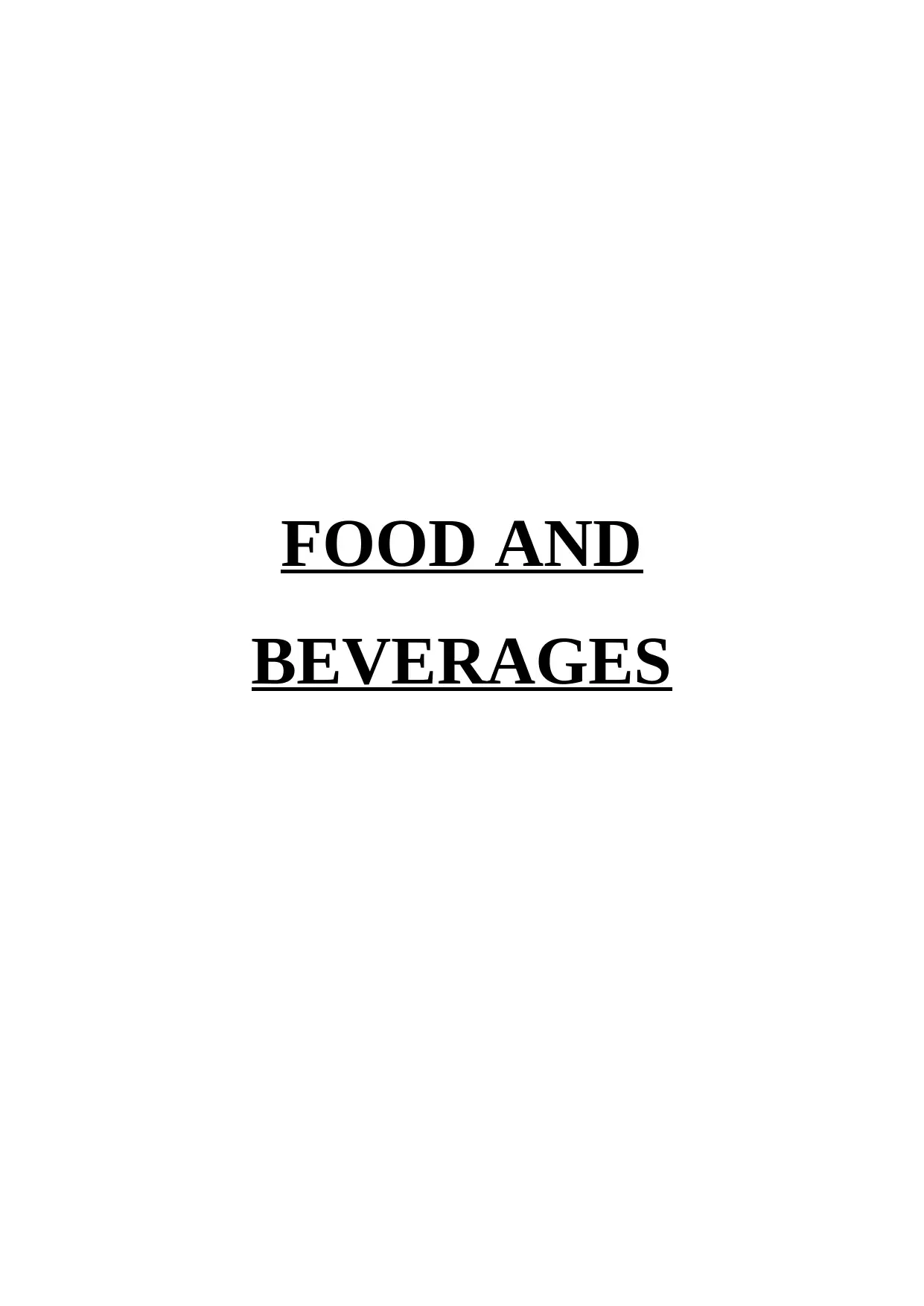
FOOD AND
BEVERAGES
BEVERAGES
Paraphrase This Document
Need a fresh take? Get an instant paraphrase of this document with our AI Paraphraser
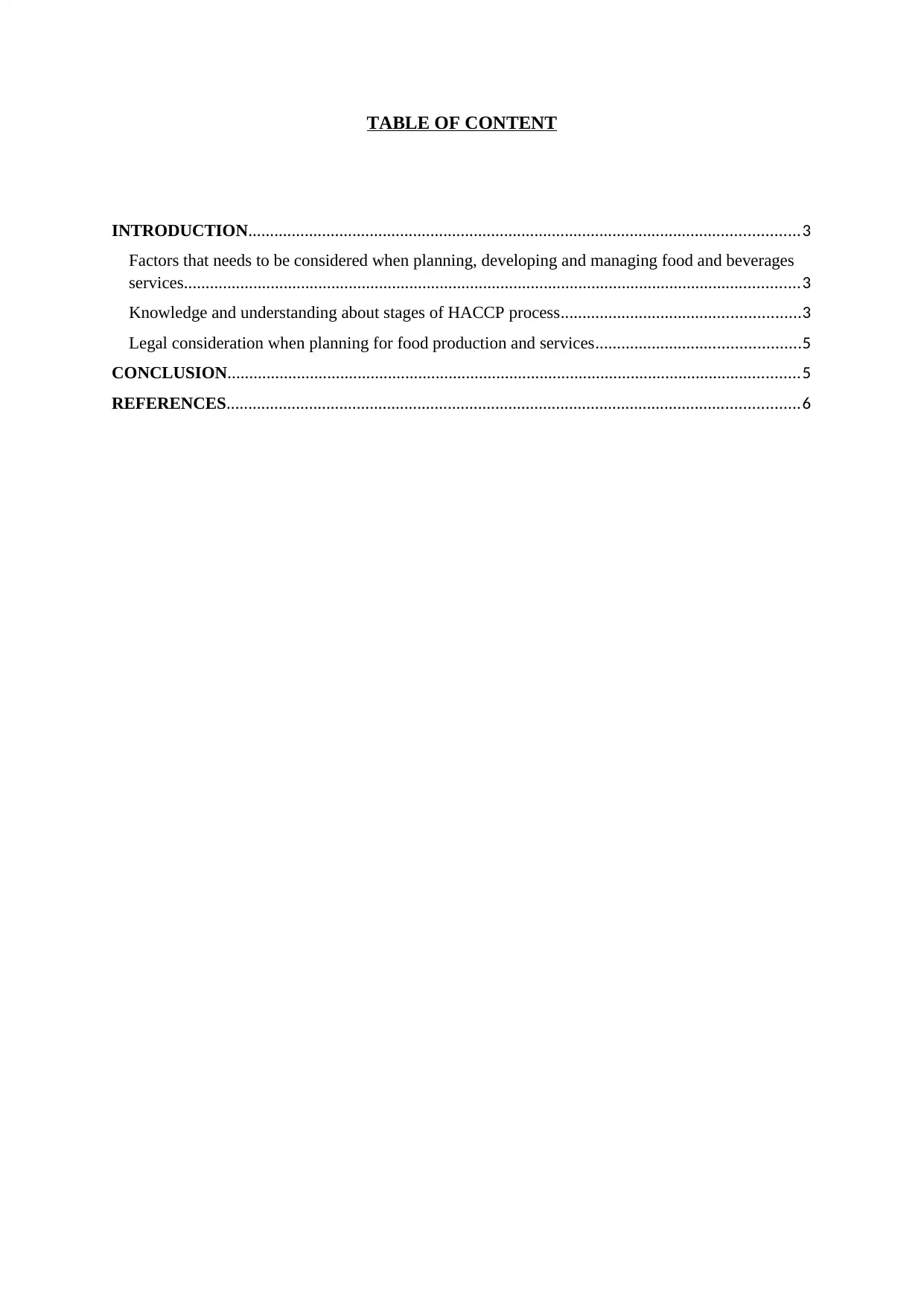
TABLE OF CONTENT
INTRODUCTION...............................................................................................................................3
Factors that needs to be considered when planning, developing and managing food and beverages
services..............................................................................................................................................3
Knowledge and understanding about stages of HACCP process.......................................................3
Legal consideration when planning for food production and services...............................................5
CONCLUSION....................................................................................................................................5
REFERENCES....................................................................................................................................6
INTRODUCTION...............................................................................................................................3
Factors that needs to be considered when planning, developing and managing food and beverages
services..............................................................................................................................................3
Knowledge and understanding about stages of HACCP process.......................................................3
Legal consideration when planning for food production and services...............................................5
CONCLUSION....................................................................................................................................5
REFERENCES....................................................................................................................................6
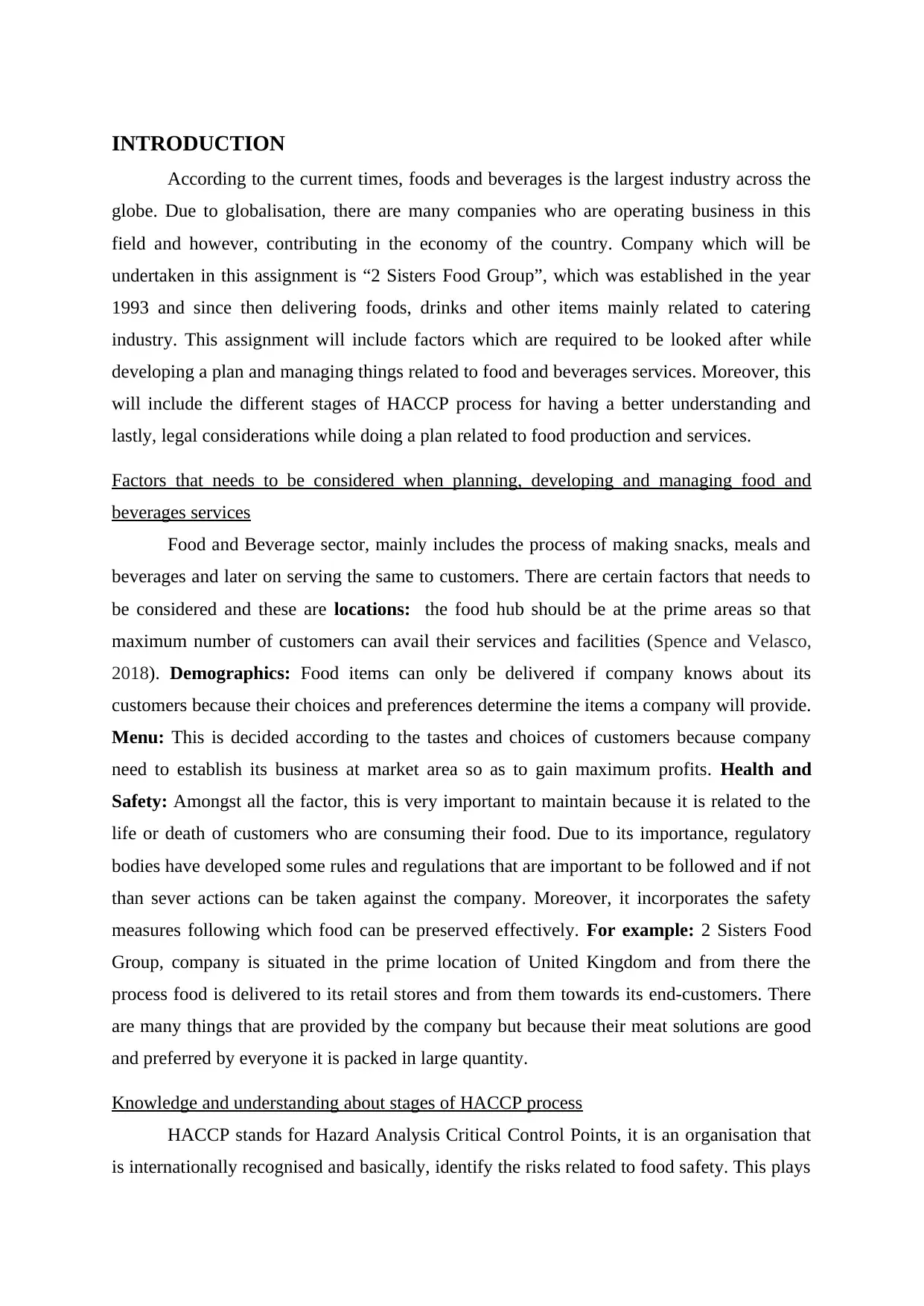
INTRODUCTION
According to the current times, foods and beverages is the largest industry across the
globe. Due to globalisation, there are many companies who are operating business in this
field and however, contributing in the economy of the country. Company which will be
undertaken in this assignment is “2 Sisters Food Group”, which was established in the year
1993 and since then delivering foods, drinks and other items mainly related to catering
industry. This assignment will include factors which are required to be looked after while
developing a plan and managing things related to food and beverages services. Moreover, this
will include the different stages of HACCP process for having a better understanding and
lastly, legal considerations while doing a plan related to food production and services.
Factors that needs to be considered when planning, developing and managing food and
beverages services
Food and Beverage sector, mainly includes the process of making snacks, meals and
beverages and later on serving the same to customers. There are certain factors that needs to
be considered and these are locations: the food hub should be at the prime areas so that
maximum number of customers can avail their services and facilities (Spence and Velasco,
2018). Demographics: Food items can only be delivered if company knows about its
customers because their choices and preferences determine the items a company will provide.
Menu: This is decided according to the tastes and choices of customers because company
need to establish its business at market area so as to gain maximum profits. Health and
Safety: Amongst all the factor, this is very important to maintain because it is related to the
life or death of customers who are consuming their food. Due to its importance, regulatory
bodies have developed some rules and regulations that are important to be followed and if not
than sever actions can be taken against the company. Moreover, it incorporates the safety
measures following which food can be preserved effectively. For example: 2 Sisters Food
Group, company is situated in the prime location of United Kingdom and from there the
process food is delivered to its retail stores and from them towards its end-customers. There
are many things that are provided by the company but because their meat solutions are good
and preferred by everyone it is packed in large quantity.
Knowledge and understanding about stages of HACCP process
HACCP stands for Hazard Analysis Critical Control Points, it is an organisation that
is internationally recognised and basically, identify the risks related to food safety. This plays
According to the current times, foods and beverages is the largest industry across the
globe. Due to globalisation, there are many companies who are operating business in this
field and however, contributing in the economy of the country. Company which will be
undertaken in this assignment is “2 Sisters Food Group”, which was established in the year
1993 and since then delivering foods, drinks and other items mainly related to catering
industry. This assignment will include factors which are required to be looked after while
developing a plan and managing things related to food and beverages services. Moreover, this
will include the different stages of HACCP process for having a better understanding and
lastly, legal considerations while doing a plan related to food production and services.
Factors that needs to be considered when planning, developing and managing food and
beverages services
Food and Beverage sector, mainly includes the process of making snacks, meals and
beverages and later on serving the same to customers. There are certain factors that needs to
be considered and these are locations: the food hub should be at the prime areas so that
maximum number of customers can avail their services and facilities (Spence and Velasco,
2018). Demographics: Food items can only be delivered if company knows about its
customers because their choices and preferences determine the items a company will provide.
Menu: This is decided according to the tastes and choices of customers because company
need to establish its business at market area so as to gain maximum profits. Health and
Safety: Amongst all the factor, this is very important to maintain because it is related to the
life or death of customers who are consuming their food. Due to its importance, regulatory
bodies have developed some rules and regulations that are important to be followed and if not
than sever actions can be taken against the company. Moreover, it incorporates the safety
measures following which food can be preserved effectively. For example: 2 Sisters Food
Group, company is situated in the prime location of United Kingdom and from there the
process food is delivered to its retail stores and from them towards its end-customers. There
are many things that are provided by the company but because their meat solutions are good
and preferred by everyone it is packed in large quantity.
Knowledge and understanding about stages of HACCP process
HACCP stands for Hazard Analysis Critical Control Points, it is an organisation that
is internationally recognised and basically, identify the risks related to food safety. This plays
⊘ This is a preview!⊘
Do you want full access?
Subscribe today to unlock all pages.

Trusted by 1+ million students worldwide
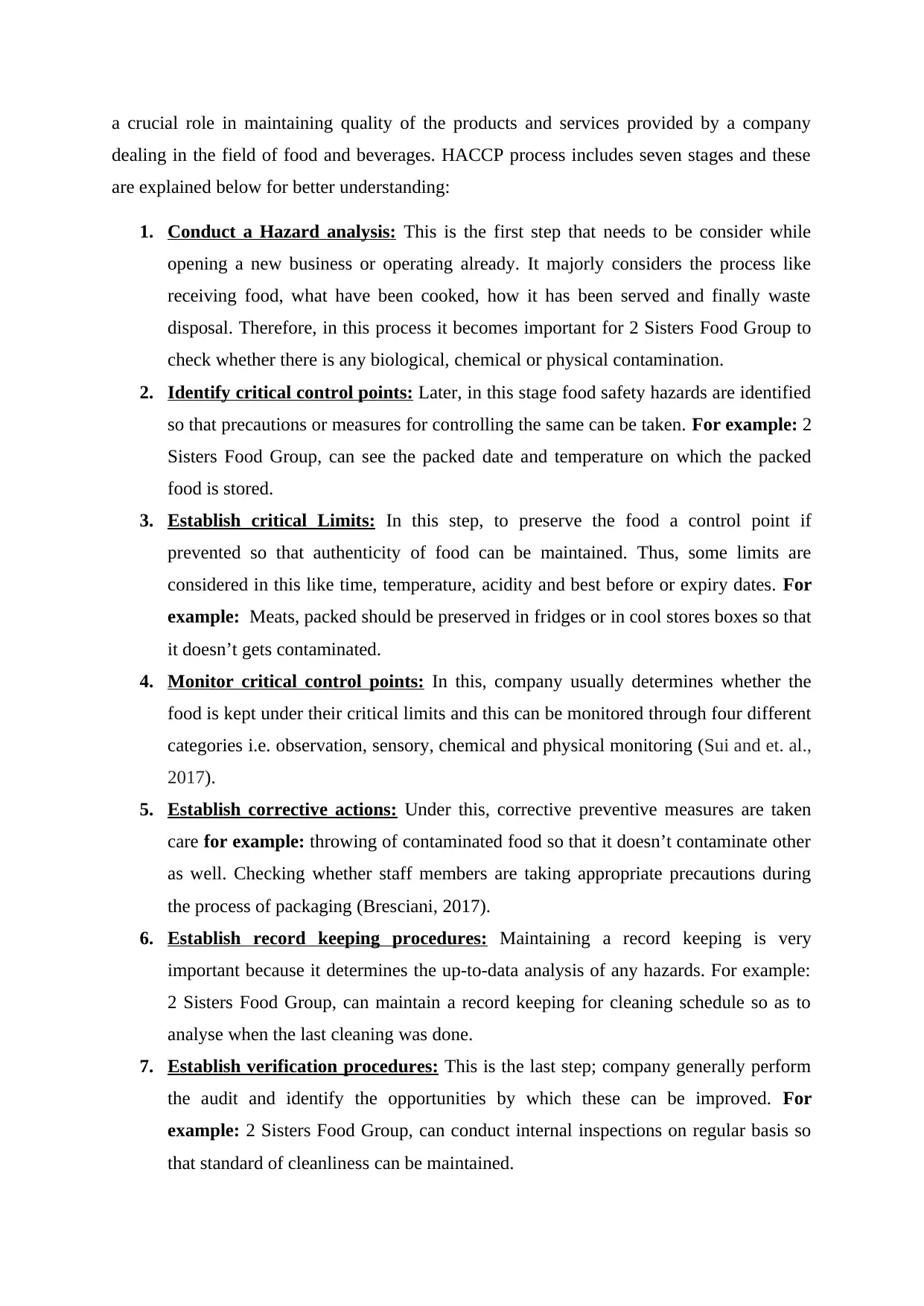
a crucial role in maintaining quality of the products and services provided by a company
dealing in the field of food and beverages. HACCP process includes seven stages and these
are explained below for better understanding:
1. Conduct a Hazard analysis: This is the first step that needs to be consider while
opening a new business or operating already. It majorly considers the process like
receiving food, what have been cooked, how it has been served and finally waste
disposal. Therefore, in this process it becomes important for 2 Sisters Food Group to
check whether there is any biological, chemical or physical contamination.
2. Identify critical control points: Later, in this stage food safety hazards are identified
so that precautions or measures for controlling the same can be taken. For example: 2
Sisters Food Group, can see the packed date and temperature on which the packed
food is stored.
3. Establish critical Limits: In this step, to preserve the food a control point if
prevented so that authenticity of food can be maintained. Thus, some limits are
considered in this like time, temperature, acidity and best before or expiry dates. For
example: Meats, packed should be preserved in fridges or in cool stores boxes so that
it doesn’t gets contaminated.
4. Monitor critical control points: In this, company usually determines whether the
food is kept under their critical limits and this can be monitored through four different
categories i.e. observation, sensory, chemical and physical monitoring (Sui and et. al.,
2017).
5. Establish corrective actions: Under this, corrective preventive measures are taken
care for example: throwing of contaminated food so that it doesn’t contaminate other
as well. Checking whether staff members are taking appropriate precautions during
the process of packaging (Bresciani, 2017).
6. Establish record keeping procedures: Maintaining a record keeping is very
important because it determines the up-to-data analysis of any hazards. For example:
2 Sisters Food Group, can maintain a record keeping for cleaning schedule so as to
analyse when the last cleaning was done.
7. Establish verification procedures: This is the last step; company generally perform
the audit and identify the opportunities by which these can be improved. For
example: 2 Sisters Food Group, can conduct internal inspections on regular basis so
that standard of cleanliness can be maintained.
dealing in the field of food and beverages. HACCP process includes seven stages and these
are explained below for better understanding:
1. Conduct a Hazard analysis: This is the first step that needs to be consider while
opening a new business or operating already. It majorly considers the process like
receiving food, what have been cooked, how it has been served and finally waste
disposal. Therefore, in this process it becomes important for 2 Sisters Food Group to
check whether there is any biological, chemical or physical contamination.
2. Identify critical control points: Later, in this stage food safety hazards are identified
so that precautions or measures for controlling the same can be taken. For example: 2
Sisters Food Group, can see the packed date and temperature on which the packed
food is stored.
3. Establish critical Limits: In this step, to preserve the food a control point if
prevented so that authenticity of food can be maintained. Thus, some limits are
considered in this like time, temperature, acidity and best before or expiry dates. For
example: Meats, packed should be preserved in fridges or in cool stores boxes so that
it doesn’t gets contaminated.
4. Monitor critical control points: In this, company usually determines whether the
food is kept under their critical limits and this can be monitored through four different
categories i.e. observation, sensory, chemical and physical monitoring (Sui and et. al.,
2017).
5. Establish corrective actions: Under this, corrective preventive measures are taken
care for example: throwing of contaminated food so that it doesn’t contaminate other
as well. Checking whether staff members are taking appropriate precautions during
the process of packaging (Bresciani, 2017).
6. Establish record keeping procedures: Maintaining a record keeping is very
important because it determines the up-to-data analysis of any hazards. For example:
2 Sisters Food Group, can maintain a record keeping for cleaning schedule so as to
analyse when the last cleaning was done.
7. Establish verification procedures: This is the last step; company generally perform
the audit and identify the opportunities by which these can be improved. For
example: 2 Sisters Food Group, can conduct internal inspections on regular basis so
that standard of cleanliness can be maintained.
Paraphrase This Document
Need a fresh take? Get an instant paraphrase of this document with our AI Paraphraser
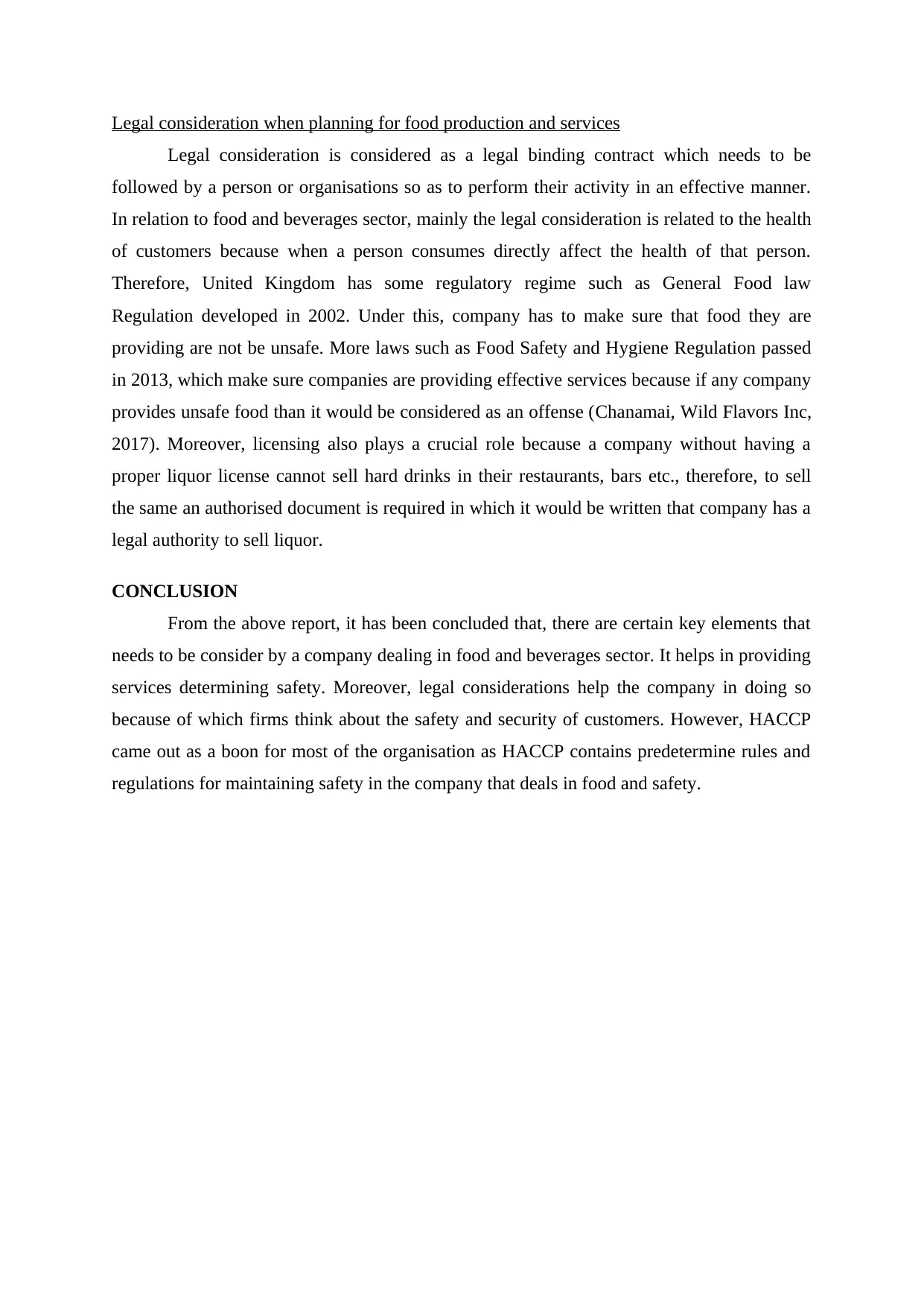
Legal consideration when planning for food production and services
Legal consideration is considered as a legal binding contract which needs to be
followed by a person or organisations so as to perform their activity in an effective manner.
In relation to food and beverages sector, mainly the legal consideration is related to the health
of customers because when a person consumes directly affect the health of that person.
Therefore, United Kingdom has some regulatory regime such as General Food law
Regulation developed in 2002. Under this, company has to make sure that food they are
providing are not be unsafe. More laws such as Food Safety and Hygiene Regulation passed
in 2013, which make sure companies are providing effective services because if any company
provides unsafe food than it would be considered as an offense (Chanamai, Wild Flavors Inc,
2017). Moreover, licensing also plays a crucial role because a company without having a
proper liquor license cannot sell hard drinks in their restaurants, bars etc., therefore, to sell
the same an authorised document is required in which it would be written that company has a
legal authority to sell liquor.
CONCLUSION
From the above report, it has been concluded that, there are certain key elements that
needs to be consider by a company dealing in food and beverages sector. It helps in providing
services determining safety. Moreover, legal considerations help the company in doing so
because of which firms think about the safety and security of customers. However, HACCP
came out as a boon for most of the organisation as HACCP contains predetermine rules and
regulations for maintaining safety in the company that deals in food and safety.
Legal consideration is considered as a legal binding contract which needs to be
followed by a person or organisations so as to perform their activity in an effective manner.
In relation to food and beverages sector, mainly the legal consideration is related to the health
of customers because when a person consumes directly affect the health of that person.
Therefore, United Kingdom has some regulatory regime such as General Food law
Regulation developed in 2002. Under this, company has to make sure that food they are
providing are not be unsafe. More laws such as Food Safety and Hygiene Regulation passed
in 2013, which make sure companies are providing effective services because if any company
provides unsafe food than it would be considered as an offense (Chanamai, Wild Flavors Inc,
2017). Moreover, licensing also plays a crucial role because a company without having a
proper liquor license cannot sell hard drinks in their restaurants, bars etc., therefore, to sell
the same an authorised document is required in which it would be written that company has a
legal authority to sell liquor.
CONCLUSION
From the above report, it has been concluded that, there are certain key elements that
needs to be consider by a company dealing in food and beverages sector. It helps in providing
services determining safety. Moreover, legal considerations help the company in doing so
because of which firms think about the safety and security of customers. However, HACCP
came out as a boon for most of the organisation as HACCP contains predetermine rules and
regulations for maintaining safety in the company that deals in food and safety.
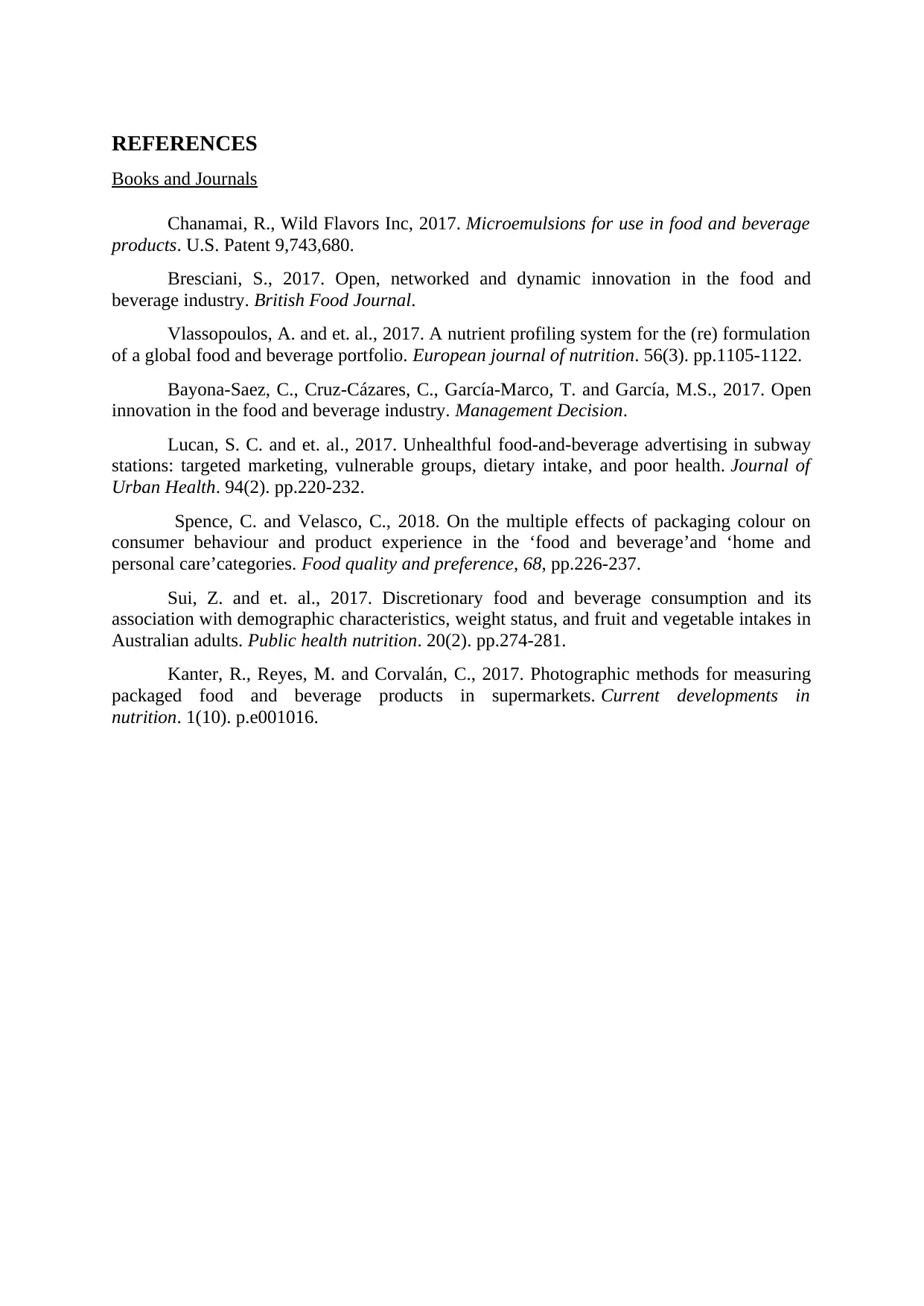
REFERENCES
Books and Journals
Chanamai, R., Wild Flavors Inc, 2017. Microemulsions for use in food and beverage
products. U.S. Patent 9,743,680.
Bresciani, S., 2017. Open, networked and dynamic innovation in the food and
beverage industry. British Food Journal.
Vlassopoulos, A. and et. al., 2017. A nutrient profiling system for the (re) formulation
of a global food and beverage portfolio. European journal of nutrition. 56(3). pp.1105-1122.
Bayona-Saez, C., Cruz-Cázares, C., García-Marco, T. and García, M.S., 2017. Open
innovation in the food and beverage industry. Management Decision.
Lucan, S. C. and et. al., 2017. Unhealthful food-and-beverage advertising in subway
stations: targeted marketing, vulnerable groups, dietary intake, and poor health. Journal of
Urban Health. 94(2). pp.220-232.
Spence, C. and Velasco, C., 2018. On the multiple effects of packaging colour on
consumer behaviour and product experience in the ‘food and beverage’and ‘home and
personal care’categories. Food quality and preference, 68, pp.226-237.
Sui, Z. and et. al., 2017. Discretionary food and beverage consumption and its
association with demographic characteristics, weight status, and fruit and vegetable intakes in
Australian adults. Public health nutrition. 20(2). pp.274-281.
Kanter, R., Reyes, M. and Corvalán, C., 2017. Photographic methods for measuring
packaged food and beverage products in supermarkets. Current developments in
nutrition. 1(10). p.e001016.
Books and Journals
Chanamai, R., Wild Flavors Inc, 2017. Microemulsions for use in food and beverage
products. U.S. Patent 9,743,680.
Bresciani, S., 2017. Open, networked and dynamic innovation in the food and
beverage industry. British Food Journal.
Vlassopoulos, A. and et. al., 2017. A nutrient profiling system for the (re) formulation
of a global food and beverage portfolio. European journal of nutrition. 56(3). pp.1105-1122.
Bayona-Saez, C., Cruz-Cázares, C., García-Marco, T. and García, M.S., 2017. Open
innovation in the food and beverage industry. Management Decision.
Lucan, S. C. and et. al., 2017. Unhealthful food-and-beverage advertising in subway
stations: targeted marketing, vulnerable groups, dietary intake, and poor health. Journal of
Urban Health. 94(2). pp.220-232.
Spence, C. and Velasco, C., 2018. On the multiple effects of packaging colour on
consumer behaviour and product experience in the ‘food and beverage’and ‘home and
personal care’categories. Food quality and preference, 68, pp.226-237.
Sui, Z. and et. al., 2017. Discretionary food and beverage consumption and its
association with demographic characteristics, weight status, and fruit and vegetable intakes in
Australian adults. Public health nutrition. 20(2). pp.274-281.
Kanter, R., Reyes, M. and Corvalán, C., 2017. Photographic methods for measuring
packaged food and beverage products in supermarkets. Current developments in
nutrition. 1(10). p.e001016.
⊘ This is a preview!⊘
Do you want full access?
Subscribe today to unlock all pages.

Trusted by 1+ million students worldwide
1 out of 6
Related Documents
Your All-in-One AI-Powered Toolkit for Academic Success.
+13062052269
info@desklib.com
Available 24*7 on WhatsApp / Email
![[object Object]](/_next/static/media/star-bottom.7253800d.svg)
Unlock your academic potential
Copyright © 2020–2025 A2Z Services. All Rights Reserved. Developed and managed by ZUCOL.



